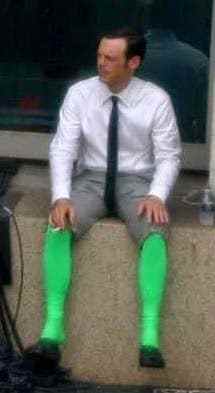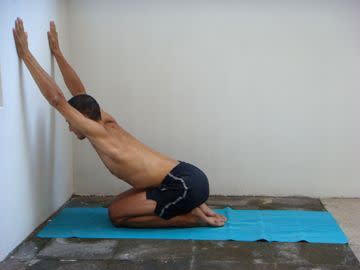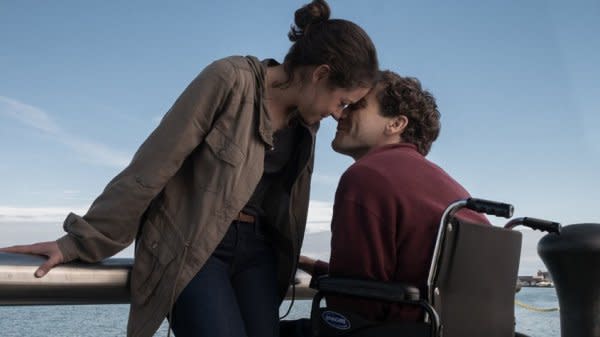How do directors shoot “missing limbs” scenes in movies?
Losing a limb is one of the most thrilling (and horrifying) events that can happen in a film. Think back to how Luke Skywalker’s hand got cut off in The Empire Strikes Back. Would he survive? And even if he does, how would life go on for him?
For filmmakers, they have a different problem. Assuming a character survives, how exactly would he or she be shown without that limb on screen anymore, especially if the actor is not an amputee in real life?
In reality, there are a number of ways to show missing limbs in film. We peel back the curtain and reveal the movie magic that goes on behind shooting missing limbs.
1. Use a green stocking

Wallace Keefe (Scoot McNairy) in Batman v Superman: Dawn of Justice. Credit: Pinterest
Green screen is the common term for “chroma keying”, where you superimpose another image/background over an existing shot. This is done by making sure that the area which is to be superimposed is all of the same colour (usually green, hence the term “green screen”). Later on, everything which is of that colour can be removed and replaced with a visual of the director’s choice.
So when movies or television shows need to show that an actor has a prosthetic limb (or no limb at all), one technique is to have that performer wear a green stocking over the limb that has to be edited out.
In Batman v Superman: Dawn of Justice, Scoot McNairy (the amputee in a wheelchair who hid a bomb that blew up the Capitol) was said to have shot a prior scene which would have showed him walking around with prosthetic legs. It’s supported by the picture above, which shows him clearly wearing green screen stockings so that his calves can be edited out later.
It’s not definitely not a fashion faux pas.
2. Practical effects/make-up
For smaller appendages, like fingers, toes or even ears, make-up will do the trick. This is known as practical effects (as opposed to digital effects), and it’s simple enough that you could do it on your own for Halloween if you wanted to.
Where does the missing appendage go, then? It’s hidden out of sight, usually bent in a position so that the camera can’t see it. But from the right angles, it looks like the finger has been totally lopped off.
3. Bend the knees or elbows as much as possible

Almost 180 degrees. Credit: Pinterest
If you can do an Asian squat or yoga, chances are you’ll have realised that it’s possible for your knee to bend almost 180 degrees, with your calf pressing against your thigh.
One of the older techniques for hiding missing limbs was to strap the actor’s calf to his thigh, and let him wear looser (but not baggy) pants. His legs would just be able to fit inside the pant leg, and it would seem as if he was missing the bottom half of his leg.
Similarly, missing arms were done by hiding the actor’s entire arm inside a looser shirt, strapped to the rest of his body. It’s uncomfortable but not painful (if you can already squat in that position, then it means that your body is capable of contorting itself to that degree).
4. Create secret holes for limbs to go through

You can scare everyone on a beach. Credit: Imgur
The hospital is one of the most common locations where a character is revealed to have lost his limb. However, since the character is sitting on a bed, what they actually do is to create a hole where the character’s leg can go through (around knee-level). Then a bandage is used to hide that insertion point, so that it looks like the character has well and truly lost his leg.
You can see a simple illustration of this principle at the beach. Bury your leg well enough in the sand, and it’ll look like a shark bit it off.
This applies to almost any place where a character is seated – as long as you make a hole, you can hide a character’s limb through it.
5. Get a real amputee to stand in
In the BBC mystery series Strike (based on the Comoran Strike series of detective novels by J.K. Rowling) (yes, that J.K. Rowling, who writes under the pseudonym Robert Galbraith), Comoran Strike (played by Tom Burke) loses his leg. For a TV series, it manages to depict his missing limb very convincingly – with one age-old technique.
They managed to get an amputee double whose limbs were about the same proportions as actor Tom Burke, but happened to be missing the exact limb as the character he was playing.
Which means that for some of the close-up shots, we’re seeing another person’s leg, not the original actor’s.
6. Avoid shots with missing limbs

Notice how Jake Gyllenhaal is framed in this shot in Stronger? Credit: Golden Village Cinemas
Perhaps the simplest technique of all is – don’t show the missing limb. After all, we don’t always see every single part of a person’s body in movies and film (otherwise every shot would be a wide shot), so it’s natural that we don’t see certain parts of the body at times.
By carefully motivating the shot sizes so that it seems reasonable that we only see a mid shot or tighter, the director can avoid shooting those missing limbs and avoid the hassle of having to use some sort of special effect to omit it.
Stronger. Credit: Golden Village Cinemas
Want to check out all those techniques in action? Then watch Stronger, a biographical drama based on real-life double amputee Jeff Bauman (played by Jake Gyllenhaal). In real-life, Bauman lost both his legs in the Boston marathon bombings, but overcame his adversity to bring hope to millions worldwide (and write a book).
It’s a film that will inspire us all.
Credit: Pinterest, Pinterest, Imgur, Golden Village Cinemas
The post How do directors shoot “missing limbs” scenes in movies? appeared first on The Popping Post.


